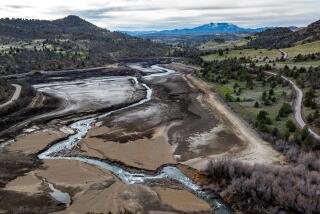Tranquil Waters Making Courtroom Waves
COEUR D'ALENE, Idaho — The shimmering waters of Lake Coeur d’Alene are a lure for boaters, fishers, swimmers and--in recent years--lawyers.
The northern Idaho lake, often referred to as one of the world’s most beautiful, is the subject of numerous recent court battles as various entities fight over control and cleanup.
The most significant decision was in mid-June, when the Coeur d’Alene tribe of Indians won a U.S. Supreme Court decision granting them ownership of the lower third of the lake. Many who depend on the lake for their livelihood are closely watching the tribe’s actions.
“The lake is so important to so many people for so many reasons,” said Bob Bostwick, a tribal spokesman. “Lake Coeur d’Alene is the significant resource in this region.”
Kootenai County, which includes much of the lake, grew 55% during the 1990s to 108,000 people. With the region’s traditional mining and lumber industries in decline, much of the growth is spurred by tourists and retirees.
Most of them are drawn to the lake and the related resorts, beaches, golf courses and marinas. Million-dollar homes and condominium complexes line the 100 miles of forested shoreline.
Epic battles occur regularly between private landowners who want to keep people out, developers who want to bring more people in, and town residents who want to ensure they retain public access to the lake.
The tribe also depends on tourists to fill its nearby casino and adjacent hotel. But Indians don’t see the lake purely in economic terms.
“It must and will be protected for the benefit of our regional economy, to be sure,” tribal Chairman Ernie Stensgar said recently. “But it must also be protected for the unborn generations, Indian and non-Indian, who will live and thrive here.”
The tribe has managed the lower-third of the lake for the last three years, since a federal judge ruled in its favor.
So far the change in ownership has meant primarily that fees for permits for fishing, docks and other uses go to the tribe instead of the state government in Boise.
But last month, the tribe told area real estate agents that it may clamp down on the number of new docks it will allow.
The goal is to reduce congestion by encouraging more multifamily docks, instead of more single-family docks, the tribe said.
Kelly Hanson, president of the Coeur d’Alene Assn. of Realtors, said the letter was something of a surprise.
“Clustering docks may be a good idea,” he told the Coeur d’Alene Press. “But people in Idaho tend to be pretty independent.”
“The message the tribe wants people to understand is that all of us need to make sure the lake is healthy,” Bostwick said.
“The tribe has had the welcome mat out to that lake for thousands of years and the welcome mat stays,” he added.
The tribe’s legal claim to the lake may not be over. Tribal officials will decide later this summer whether they want to pursue ownership of the entire lake in federal court. It appears they might.
“We have been here as long as the lake itself,” Stensgar said. “It is the center of our homeland and we . . . are the historical, cultural and traditional products of the lake.”
The tribe is also pushing a lawsuit to force mining companies to pay the cost of cleaning up pollution from a century of mining in Idaho’s Silver Valley. Much of that pollution washed down into the lake, resting on the bottom.
The United States and the tribe sued the companies under the Superfund law--a federal statute that requires polluters to pay for the cost of cleaning up contaminated sites. The bill to cleanup the site could be as much as $3 billion. If U.S. District Judge Edward Lodge of Boise rules that the companies are liable, a second trial would determine how much each should pay.
Asarco Inc. and Hecla Mining Co. are trying to prove in court that they should not be liable for part of the cleanup cost. Three other firms have settled their lawsuits.
The tribe claimed that most of the heavy metals in the lake came from Asarco and Hecla. The mining companies contend the government shares responsibility for contamination because it kept the mines running during World War II.
The U.S. Environmental Protection Agency has long maintained that the lake serves as a de facto repository for decades of toxic mine waste.
But the agency has also concluded the lake meets the federal drinking water standard for heavy metals and that its beaches are safe for people to use.
More to Read
Sign up for Essential California
The most important California stories and recommendations in your inbox every morning.
You may occasionally receive promotional content from the Los Angeles Times.










